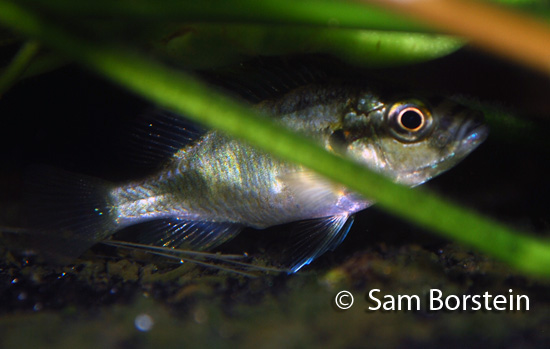Astatotilapia burtoni
(Günther, 1893)
Burton's Mouthbrooder
Synonyms: Haplochromis burtoni

Above: A male yellow Astatotilapia burtoni. Photo by Sam Borstein.
Etymology:
Genus- Astato= unstable (Greek), tilapia= fish (Native African).
Species- burtoni= Named after Sir Richard F. Burton, an explorer.
Intro:
Astatotilapia burtoni is essentially a Victorian cichlid in the middle of Lake Tanganyika. This fish occurs throughout other rivers and creeks around Lake Tanganyika, so many color varieties occur. This is one of the first Haplochromis types to be bred heavily in the hobby.
Distribution:
Astatotilapia burtoni is found in Lake Tanganyika and its surrounding creeks and rivers. The fish can also be found in swamps. This fish has an extreme amount of variability and Lake Tanganyika has bot a blue and yellow morph of this fish.
Size, Maturity, and Sexual Dimorphism:
Size: Males- 5 inches, Females- 4 inches
Maturity: 1 inch
Sexual Dimorphism: Males are larger and have color compared to the brown/silver females.

Above: A female Astatotilapoa burtoni. Photo by Sam Borstein.
Care:
I found Astatotilapia burtoni males to be very aggressive. I started with 8 fish, 3 males, 5 females when they were about an inch long. Within the first two weeks, the dominant male knocked of the other two males, and two females. I really recommend a large tank, preferably at least 4 feet long, piled high with rocks and hiding spots for the fish. Keep this fish with other aggressive fish, like mbuna types.As far as water, hard water is perfect. water changes should be done every other week, weekly even better.
Diet:
This fish is an omnivore, so feed a balanced diet. Mine did great on a mix of flakes and pellets.Breeding:
If you can keep the male from terrorizing everyone, this fish is easy to breed. Females get gravid, produce eggs, and spawning occurs like that of Victorian cichlids.Females are great holders and hold for about 16 days. The broods tend to be small and so are the fry. Fry grow fast though and are an inch in about 5 weeks. It's super easy to raise the fry on baby brine shrimp first and then crushed flake.
Conclusion:
Astatotilapia burtoni is not a fish you will commonly see, but if you like Victorians, give this Tanganyikan a try as it is pretty much a Vic. This fish is starting to become more and more popular in hobbyist circles.